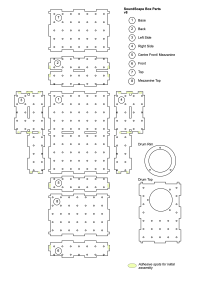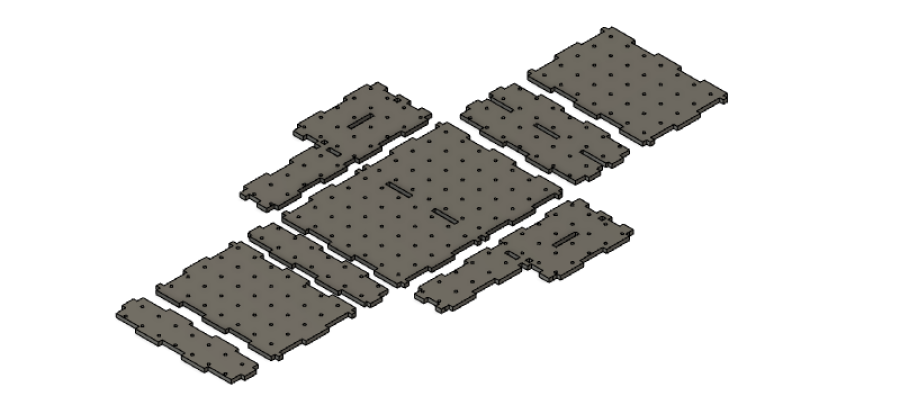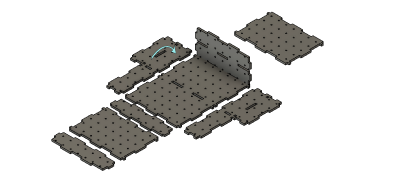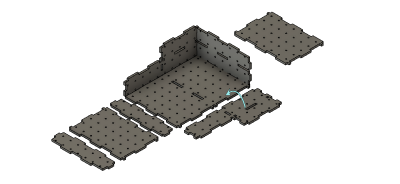Developing the DIY Soundscape Box Try It
Acknowledgement
We acknowledge Aboriginal and Torres Strait Islander peoples and their continuing connection to land and as custodians of stories for millennia. We respectfully acknowledge the land on which we all meet today, and pay our respects to elders past, present and emerging.
Summary
Most of the time we don’t stop to hear the textures of the sounds around us. It can be difficult to slow down and let the colour of the sounds around wash over us. Its also an interesting artistic exercise to explore the expressiveness of found sounds like a sculpter might utilise a found object.
In Aug 2020 Applied Creativity invited participants to engage with a series of two online workshops participants will come together on zoom to build and customise their own unique percussive musical instrument, and then experiment with it sonically in a collaborative online space. The idea was that participants would make a basic recording of a soundscape performance or an abstract sound design for a short film. These workshops were designed for anyone who enjoys handmaking unusual stuff, people who might be interested in training the sensitivity of their ear and anybody who has been missing coming together with other people and being creative. No specific making or musical experience required.
In a face to face workshop its recommended that a 3rd workshop be added to allow participants to learn about and build their own contact microphones. It is not recommended that this be done in a remote/online workshop as this would require equipment (soldering iron, hand tools, etc ) and the micro size of the components are not well suited to zoom (you'd need a usb microscope as a webcam for this). Documentation for the building of Contact Microphone and PreAmp can be found here.
Skills / Themes Explored
Less than a Skills development workshop these sessions were designed in the format of a masterclass. To allow participants to:
- Develop and refine sonic sensitivity.
- Construct, customise and sonicaly explore a cheap DIY percussive instrument.
- Explore the commercial online meeting platform Zoom as a space for creative collaboration and social learning.
- Individuals and or the group making a short, simple audio recording of improvised performance on a personal device
- Explore instrument making as gateway drug to making.
Materials and equipment
Participants will require a computer
- with a reliable connection to broadband
- and have the capability of installing the Zoom application and Audacity.
It is also preferable for all participants to have a stand-alone-Webcam.
It also turned out to be useful to have a smart phone with a audio recording app.
The workshop participants were sent out a kit with everything else the need to construct their Soundbox instrument
- Laser cut box parts
- metal springs
- rare earth magnets,
- balloons, rubber bands
- fencing wire
- a length of Aluminium Strip
- construction adhesive and applicator
- nuts, bolts and washers
- laser cut thumb socket for turning screws
- a contact microphone and with preamp. (making this would be the third workshop in a Face -to-face version - to much to do this on Zoom without Solding equip.
Preparation
- Secure Postal address to ship kits to all participants https://forms.gle/BiGiMTywwf3CKwoi8
- Laser cut box
- Assemble kit incl box hardware
- Assemble Contact Microphone & Preamp
- Mail out kits in advance of 1st workshop
- Assemble playlist of Creative Commons video content
- Assemble Wordcloud of sound describing words and strategies
Session Plans
Workshop 1
have wintergatan marble machine video welcome participants as they arrive
Step Zero
- This is a TryIt Workshop
- Its the first time we're run this workshops. Maybe the Last

- This is why its so cheap.
- Your feedback will help us make it better.
* Intro to hands-on workshops in Zoom (10 min)
By now many of us have started to get used to participating in meetings and talks via streaming and conference call platforms. It would easy to think that now we've had some experience with these we'll know what to do in an online workshop. But the behaviours seen and etiquette performed in a successful talk or or business meeting is probably different to a successful social learning activity or collaborative workshop. Its easy to fall back into be a passive spectator on these platforms but we are interested in enhancing engagement and exploring the platform as a site for remote collaboration - i'd rather be in the room with you all but the fact that these platforms could open up the opportunity for us to collaborate remotely is really exciting and worth exploring. So Lets talk about what might make for a positive online workshop experience.
Lots of people are refering to these as ZORMS
- Make sure you can hear everyone, and make that we make space the hear everyone
- Don't be affraid to chat
- Be prepared for but try not to stress about interruptions or technical issues
- use your inside voice
- Backgrounds
- To mute or not to mute… this is the question
- Assign/assume roles
- hand gestures
- hand emote
- don't be afraid to share screens
- try and have a helper
and consider what you'd do in a face to face situation.
* Media Consent and IP issues (5 min)
Copyright and Media consent principles were not developed with this kind of activity or the Zoom platform in mind. (an online application for live recording of you and your individual and collaborative original creative works in your own home).
Normally in a face to face workshop we'd ask you to sign a paper form giving us consent to take and publish photo, film or sound recording documentation of you participating in the activity.
But thats also complicated when we are also creating/ recording individual and maybe collaborative artistic works for which you'll have artistic rights. So right now i'd like to negotiate consent for the collaborative works. We'd like to be able to share what you made at the end of the workshop (probably in a blogpost) so right now i'd like to record each of you giving your consent to record/ capture a recording of your participation and any artistic contributions, i'd like to be able to publish your contributions for the purposes of documenting/ publishing the the outcomes of the workshop and promoting other workshops like this in the future.
A third intellectual property issue connected to this is that we'll be making use of open source/ creative commons license video content in our 2nd workshop. Now as this workshop is an educational or learning setting, we could claim a fair use of any material open source or copyrighted - Fair use clauses under the Australian copyright act allows use for the purposes of:
- research or study
- criticism or review
- parody or satire
- reporting the news
- provision of legal advice.
but outside of the workshop if you want to start creating derivative works - making and publishing soundscapes for other people's video content you'll need to get permission or publish the work under a creative commons licence.
- Intro to the Facilitator and the Workshop (5 min)
In this workshop i'll be channeling Mick from 20 odd years ago in the early nooties when i was spirited young live performance creator from Toowoomba completing my honours degree, and commencing work as a community arts worker - serious stuff. Around this time I was:
- lucky to secure a residency at the 1st Time_Place_Space, Ozco's weeklong residential camp for new media performance creators from across australia,
- i was creatinging an multi disciplinary performance adaptation of a Franz Kafka short story for my Honours Thesis and
- teaching young unemployed people post structural theory and post modern performance and visual art in my Art for the Dole project.
it was all very serious and wanky but a through line through all these things was playing with sound.
When i saw Koka’s Soundtrack Box No. 1 and the Sounds of the Nightmare Machine video it awakened something in me. ![]()
- Show stimulis videos (5 min)
So this workshop is a bit different to alot of our others. Its might be considered a bit esoteric. Alot of people would say its not something that will get you a job. But lets not get into that. Lets talk about what its trying to be… So Goals for us in this workshops series are to focus on
- Developing and refining our sonic sensitivity (after getting around in the noisey would we don't hear whats around us anymore) and a sonic vocabulary (the collection of repeatable sounds we can use to communicate and express ourselves creatively).
- Construct, customise and sonicaly explore a cheap DIY percussive instrument.
- Explore the commercial online meeting platform Zoom as a space for creative collaboration and social learning.
- Individuals and or the group making a short, simple audio recording of improvised performance on a personal device
- Dabbling in DIY musical instrument making as a catalyst to “gateway drug,” to more sophisticated making - which is what The Edge and the Fab Lab promotes.
Denis Leary said it best when commenting on the catalysts for the creative urge to make (in this case constructing a bong). “They say marijuana leads to other drugs! No it doesn't! It leads to f@*$n' carpentry! ”
So I hope this is what you are here for - Lets find out.
- Participants intro themselves-interest in the workshop, what do you like to make, favourite sound. (10 min )
Step 1
- Test sounds on the desk/ in you hands.
How many sounds can you make? Whats the cliche? What's novel sound?
- Cardboard,
- ruler,
- spring,
- balloon,
- rubberband.
* Demo & Assemble Box (10 min)
- Layout parts like diagram
- Note only glue marked parts initially
- Demo Assembly
- Participants build
BOX ASSEMBLY Lets put it together first without glueing anything
Step 1 - Layout all parts like in the diagram ( this layout is on the back of the parts list that came with your kit.) 
Theres a diagram of this on your parts sheet.
Step 2 - Add the back to the base
Step 3 - Add the Left Side to the base
Step 4 - Add the Right Side to the base
Step 5 - Add the Centre Front / Mezzanine front
Step 6 - Add the Front
Step 7 - Add the Top
Step 8 - Add the Mezzanine Top
3D view of assembled box hit the explode icon ![]() and manipulate the slider to see the parts come together.
and manipulate the slider to see the parts come together.
Step 9 - We want to be able to fit our other parts and experiment so we'll only want to glue some parts at this stage. SO NO GLUE ON TOPS OR THE BOTTOM AND NO GLUE ON THE PARTS THAT TOUCH THEM.
The easiest way to do this is to remove one part at a time and glue it. Use a rubber band or two to hold it together while you are working
- Install Free Compression Spring (via nut, bolt and washer)(5 mins)
- Install a Rubberband bass and discuss steel string (5 mins),
- Assemble beater, Demo a brush (10 min)
Break Play more videos while people catch up or get a drink.
Step 2
- Demo and Install Counterweight blade, (10 mins),
- Demo a balloon drum head (5 min)
- Demo attaching tension spring (via hardware strip, nut, bolt and washer)
- Demo steel string
- Demo a Thumb Piano balloon drum head (10 min)
Step 3
- Explore and document Sonic Vocabulary (Make and document 10 sounds)(10 min)
Saying “explore and document a sonic vocabulary” is a very loaded sentence that needs to be unpacked and assumes some principles of shared understandings- So let reiterate -
- The eventual outcome in this workshop series is performing and recording a kind of expressive soundscape made of found sounds for a short film.
- This an exercise in scoring - and the artist that do this (film score composers) can treat sounds as a language for communicating with an audience
but being proficient and communicating in this way, requires a composer to possess a vocabulary of sounds the composer to speak to her audience.
- so in this section of the workshop we are going to establish a way to experiment and document (record somehow so we can remember how to replicate them)
And this will provide us with a vocabulary or pallet of sounds for the performances we'll make in the 2nd week of the series.
- so we need some language to transcribe the sounds we are making.
Theres lots of ways people describe a sound:
- how you made a noise “striking the side of the box with a muffled beater”
- you can use colours,
- feelings,
- textures and
- onomatopoeia
Eg “ an earthy brown thudd” or “uplifting, bright, chirpy tinkles over a metallic thrum” to describe the sound of running a plectrum over a compression spring under tension.
I made an interactive word cloud of about 600 concepts you could possibly use to describe a sound
- Break off into pairs and share explore together. (10 min)
Participants might feel uncomfortable when asked to go off into “breakout” rooms in pairs and could just sit there in silence. Participants would need to be encouraged to engage in this way -its actually no different from a face to face workshop situation and would hopefully understand that this is a big part of the point of the workshop.
If numbers of participants are low then facilitator could consider doing the exercise “around the circle”
- Share favourites within the broader group(10 min)
Step 4
Contact Microphones (5 min)
Step 4
- Film Stimulis Preview
- Homework - customisation of your box and vocab development https://docs.google.com/document/d/1iKJzqDcph21uwMmb8l9CVeBVV8Br3E3Vc_3XPa5puyU/edit?usp=sharing
- TryIt Reflection
- Did we have enough time?
- Anything missing?
Workshop 2
Step Zero
- Check participants have Audacity installed.
- Check Contact Mic/ Preamp is working ( in system preferences)
Step 1
- Welcome back
- Revise what we did last week
- Talk about what we are going to do this week
- how to hook up your contact mic
- how a piezo works
- pros / cons of contemporary consumer electronics, (TRRS and filtering out noise)
- Share customisations (10 min) & * Share Vocab (20 min)
Consider whether we want to work as individuals, small teams or a mix of both
Step 2
Connecting your contact Mic and a Brief intro to Audacity Selecting the Contact Mic as a source monitoring in Audacity !
- Recording
- selecting
- trimming
- The Effects menu - Amplify, normalise
- Saving and exporting.
If you are interested in a more indepth intro to Audacity you can find more info on the wiki Audacity
Recording using an iPhone
- Record using voice memo or Garageband voice memo share file M4A (ACC). you need to download library before opening these in Audacity.
Recording using an android
coming soon
Step 3
Select a video clip, individually or in small groups, https://vimeo.com/groups/660321
- break down the clip into beats (component parts) and story board the clip with an emphasis on what are the different components that could be complimented by your soundscape.
- take turns to improvise or jam around the clip.
- stop and consider discuss
- rehearse
- record
- fill out the info sheet Soundscape Project info
and upload to google drive.
You may like to consider some of the principles of sound design for film detailed in list of film sound terminology, particularyMichel Cheon's concepts of:
Audiovisual Contract - an agreement to forget that sound is coming from loudspeakers and picture from screen
Empathetic Sound - music or sound effects whose mood matches the mood of the action
Anempathetic Sound - music or sound effects that seems to exhibit conspicuous indifference to what is going on in the film's plot
Temporalization - influence of sound on the perception of time in the image
Acousmêtre- a kind of invisible voice-character with mysterious powers
Synchresis - the mental fusion between a sound and a visual when these occur at exactly the same time
Step 4
Share and Discuss recordings
Step 5
Reflect on the workshop.
Possible questions to discuss
- Did you enjoy this slightly esoteric workshop?
- Would you like more of these?
- Did you enjoy collaborating on Zoom?
- What recommendations would you make for future workshops of this nature?
- What do you think about adding 3rd workshop (possibly in the at the start or middle) to make a contact microphone and preamp.
- What did you think of the kit?
- Was there anything we could add that would make it awesomer?
Feedback and Reflection after the workshop
The Kit
On the whole the kit seemed successful and provided everything required to inspire people and get them started in their sonic exploration. Some participants seemed impressed with the range of things that could be done with simple materials and were enthusiastic about trying out the sonic potential of the odds and sods around them in their house (kinda the point). Just as I had erred on the use of cardboard construction of the box participants feedback that they would have preferred a timber sound box (though this could have doubled the cost of the kit)
Incidentally costs for this workshop (buying in bulk and with some lead time to buy from cheaper vendors ) would be as follows
Soundscape Box Kit
- Nuts and bolts $3
- Cardboard $0.50 (plywood $6)
- Adhesive $1.50
- Craft odds and ends (rubberbands, springs, sticks, string balloons ) $1
- Aluminium strip $0.80
Total - $6.00
PLUS $6/8 for Postage/ Delivery by a courier
The modular design of the box was well received though the
The Contact Mic & PreAmp
The easy experiences i'd had running Contact Microphone workshops in the past (before the wide spread use of TRRS cables and Plug and Play Mic filtering) was serious disadvantage to the development of this workshop. I thought i'd just plug in a simple Piezo like i always had. I honestly didn't leave it till the last minute - i started conscientiously working on the development 4 months in advance of the first workshop but a mix of setbacks and the difficulties of developing during the pandemic (development either at home without tools or intermittently when i got access to the lab and without face-to-face feedback from colleagues) a finished prototype for the circuit was not completed until 3 business days before what was supposed to be the final workshop of the series. I even seriously considered whether we could run the workshops without the Contact Mic but reflection after the first workshop, enforced for me the centrality that the contact mic should play in this workshop.
Contact Mic & Preamp
- Piezo $0.70
- Cable + Heatshrink $1.50
- 9v battery $2.00
- components $4.00
- Audio Connector $2.00
Total ~$10.00
The First Workshop
The Second Workshop
On a personal note
Laser Box Files
References
SONIC STIMULIS
Sounds of the Nightmare Machine Apprehension Engine
Bradford Reed and his pencilina in SOHO
Western classification of musical instruments
Autonomous sensory meridian response
DESCRIBE SOUNDS
Wikipedia List of onomatopoeias
words used to describe music and instruments
204 words that describe colours
List of Words describing feelings
CONTACT MICROPHONES
https://makezine.com/2011/12/20/collins-lab-diy-contact-mic/
https://makezine.com/projects/make-38-cameras-and-av/piezo-contact-mic/
https://www.cablechick.com.au/blog/understanding-trrs-and-audio-jacks/
https://sound.stackexchange.com/questions/687/diy-contact-microphone
Using Contact Microphones Right
The First Rule of Contact Mic Club
https://www.cnet.com/how-to/hear-hidden-sounds-with-a-diy-microphone/
https://diyvideostudio.com/connecting-external-microphone-for-iphone-video-recording/
OPEN SOURCE VIDEO CONTENT
Reflections On Soundscape Box Feedback Session
by Mick Byrne
On 16 July 2020 Andrei Marberley and past music technology intern/ facilitator Matt Davis participated in an abridged trial of the 1st workshop in the series over Zoom. In preparation for this a kit with most parts was sent out. This session has a limited max time of 90 min. Phil Gullberg also attend most of the session in order to capture photographs of the session.
The Feedback session was started by explaining that both Cardboard and Plywood version of box were sent out in order for Matt and Andrei to give feedback on which box was preferable (the Cardboard next to nothing to produce and plywood about $15 to produce).
Also explained the difficulty that we have had getting the contact microphone to interface with contemporary laptops and smartphones, but that we would try not to get bogged down in this with our limited time.
Topics for Further Discussion
Microphone Input
TRRS/ 4 pole Jacks and sockets on Laptops and Smartphones
The wiring on TRRS or 4 Pole 3.5mm jack/plugs is different for different devices. For the purposes of the workshop it makes sense for participants to be able to plug their Contact microphone into the PC or mac they are using to access zoom. But the usability of the contact mic is enhanced if it is portable and they can plug it into their smartphone. (also smartphone compatibility gives us an important plan B if the PC/ MAC connection does not work - a plan being important factor in delivering remote/online workshops.
https://www.cablechick.com.au/blog/understanding-trrs-and-audio-jacks/
PreAmp
We have also learnt (suspect) that the addition of a preamp guards against contemporary applications like Zoom and smartphone audio recorders treat the weak signal of an un amplified contact mic as electronic Noise and filtering out effectively ignoring the signal. Collin's contact mic and 9v Preamp on MAKEzine.com
Youtube video of Collin's Lab contact mic / 9v Preamp
Data shet for the MPF 102 tranistor used in the preamp circuit
Sonic sensitivity
- compare medical and artistic approaches
Zoom as a space for creative collaboration and remote social learning online
Stand-alone-Webcam
to mute or not to mute- this isn the question



















